This is a list of notable people from Antwerp, who were either born in Antwerp, or spent part of their life there.
This is a list of notable people from Antwerp, who were either born in Antwerp, or spent part of their life there.
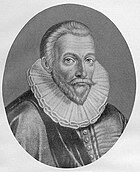




Ghent is a city and a municipality in the Flemish Region of Belgium. It is the capital and largest city of the East Flanders province, and the third largest in the country, after Brussels and Antwerp. It is a port and university city.
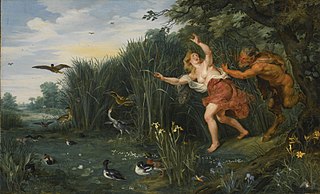
Jan Brueghelthe Younger was a Flemish Baroque painter. He was the son of Jan Brueghel the Elder, and grandson of Pieter Bruegel the Elder, both prominent painters who contributed respectively to the development of Renaissance and Baroque painting in the Habsburg Netherlands. Taking over his father's workshop at an early age, he largely painted the same subjects as his father in a style which was similar to that of his father. He gradually was able to break away from his father's style by developing a broader, more painterly, and less structured manner of painting. He regularly collaborated with leading Flemish painters of his time.

Gorinchem, also spelled Gorkum, is a city and municipality in the western Netherlands, in the province of South Holland. The municipality covers an area of 21.93 km2 (8.47 sq mi) of which 3.10 km2 (1.20 sq mi) is water. It had a population of 37,410 in 2021.
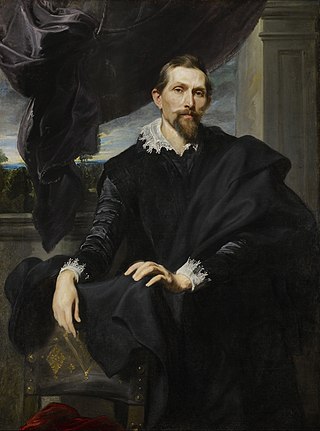
Frans Snyders or Frans Snijders was a Flemish painter of animals, hunting scenes, market scenes, and still lifes. A versatile artist, his works depict all sorts of foods, utensils and tableware and wide assortment of animals. He was one of the earliest specialist animaliers and he is credited with initiating a wide variety of new still-life and animal subjects in Antwerp. His hunting scenes and still lifes engage the viewer with their dramatic and dynamic effects. He was a regular collaborator with leading Antwerp painters such as Peter Paul Rubens, Anthony van Dyck, Jacob Jordaens and Abraham Janssens.
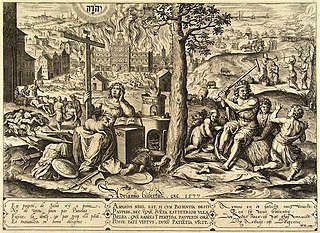
Jan Collaert the Elder or (I), Hans Collaert the Elder or Johannes Collaert (Brussels, between 1525 and 1530 – Antwerp, October 1580) was a Flemish printmaker, publisher, draftsman, tapestry designer, glass painter and designer and engraver of swords. He was the founder of a dynasty of engravers that would play a significant role in establishing Antwerp as one of the leading centres for printmaking in Europe in the second half of the 16th century and the early 17th century.

Jan van Beers was a Belgian poet born in Antwerp. He is usually referred to as "van Beers the elder" to distinguish him from his son, Jan van Beers (1852–1927), the painter.

Jan Frans van Bredael or Jan Frans van Bredael the Elder was a Flemish painter known for his landscapes, battle scenes and equestrian paintings. A prominent member of the third generation of the van Bredael family of painters of Antwerp, he was active mainly in his native Antwerp. He worked also in London and Paris where he enjoyed the patronage of an aristocratic clientele.

The Francken family was a family of artists the members of which were mainly active in Antwerp in the 16th and 17th centuries. Many of the members over three generations had the same first names Frans, Hieronymus and Ambrosius. While this may at the time have been effective as a marketing method by ensuring continuity of the family business, today's legacy is some confusion in the attribution of paintings, which often do not differ widely in style or execution between the various family members. The confusion is exacerbated by the signing practices of some family members: when Frans I's son Frans II reached his majority and began to sign paintings, Frans I started to add "the elder" to his signature to distinguish himself from his son, who then signed his works as "the younger". This happened again in the next generation when Frans II's son Frans III reached his majority. Frans II then started to sign his works with the elder, while Frans III used Frans the younger.
Events from the year 1647 in art.
Events from the year 1690 in art.
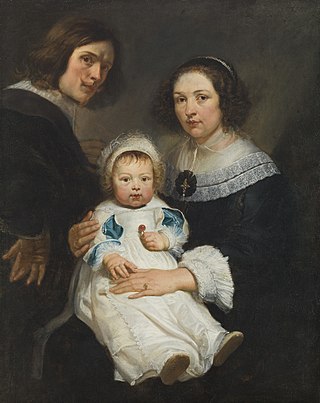
Erasmus Quellinus the Younger or Erasmus Quellinus II was a Flemish painter, engraver, draughtsman and tapestry designer who worked in various genres including history, portrait, allegorical, battle and animal paintings. He was a pupil of Peter Paul Rubens and one of the closest collaborators of Rubens in the 1630s. Following Rubens' death in 1640 he became one of the most successful painters in Flanders. He was a prolific draughtsman who made designs for decorative programmes in the context of official celebrations, for publications by the local publishers and for tapestries and sculptures realised by the local workshops. His work reveals the Classicist trend in the Baroque.

Frans Francken the Younger was a Flemish painter and the best-known and most prolific member of the large Francken family of artists. He painted large altarpieces for churches as well as smaller historical, mythological and allegorical scenes. His depictions of collectors' cabinets established a popular new genre of art in the era. Francken often collaborated with other artists, adding figures and narrative elements to scenes created by specialists in landscape, architectural and floral still life paintings.
The Dutch male given name Hendrik is a cognate of the English Henry. The spelling Hendrick or Henderick was interchangeable until the 19th century. Birth names of people with this name can be Latinized to Henderickus, Hendricus, Hendrikus, or Henricus, while common nicknames for Hendrik are Han, Hein, Henk, Hen, Hennie, Henny, Henrie, Henry, Hendrie, Hendry, Rijk, Ric, Rick, Ricky, Rickie, and Rik. People with Hendrik, Henderick, or Hendrick as their first name include:
Slodtz's father, Sebastien (1655-1726), was also a sculptor, born at Antwerp.....